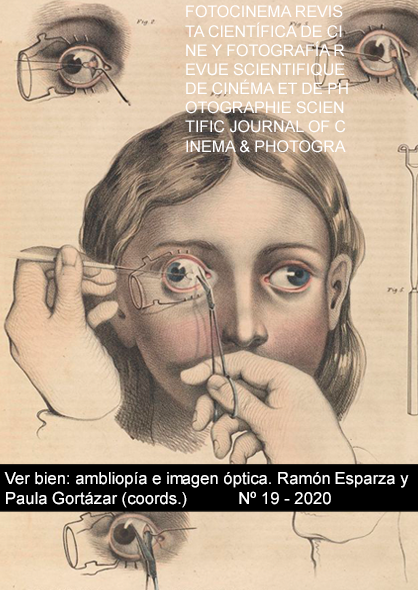The dance, a corporeal narrative of horror in Luca Guadagnino’s Suspiria
DOI:
https://doi.org/10.24310/Fotocinema.2019.v2i19.6661Keywords:
Body, Contemporany Dance, Horror, SuspiriaAbstract
The following article tries to analyze the dance in the Luca Guadagnino’s last film, Suspiria, a extended remake classic of terror, Suspiria of Dario Dargento. The dance is a fundamental rol because the corporeal movement is the soport where the dramatic action and the mysterious and the horrible inscribes in Suspiria of Guadagnino. For that purpose, we are going to study the body from the posestructuralist philosophy and the psicoanalysis for understand the different imechanisms with is build the corporeal horror and power in this work. The dance turns into an invisible personage, it takes power about dancer’s bodies until incompressible limits. It suposses a regret at the pre-aristotelic origins, when the dance was the joining with the nature, the medio where individuals interect and express their emotions. We will comprove how the dance covers to the cinematographic and narrative spaces, allowing to blessed spectator and without any tool for defende against horror in the film of Guadganino.
Downloads
Metrics
References
Abad, A. (2004). Historia del ballet y de la danza moderna. Madrid: Alianza Editorial.
Artaud, A. (2005). Le théatre et son double. París: Gallimard Éditions, 1943.
Bataille, G. (1998). Théorie de la religion. París: Gallimard Éditions, 1973.
Ciruela Bernal, v. (2014). Danza y cinematografía a través de la obra de Wim Vandekeybus y su película Blush. Revista Danzaratte: Revista de Conservatorio Superior de Danza de Málaga, 8, pp. 26-40.
Cixous, H. (2010). Le rire de la méduse. París: Éditions Galilée, 1968.
Deleuze, G. Guattari, F. (1987). Mille plateaux. París: Éditions de la minuit.
Duncan, I. (2003). El arte de la danza y otros escritos. J. A. Sánchez (ed.). Madrid: Akal.
Fischer-Lichte, E. (2004). Estética de lo performativo. Madrid: Abada Editores.
Foucault, M. (2003). Surveiller et punir. Naissance de la prison. París: Gallimard Éditions, 1975.
García, Y. (8 de diciembre de 2018). Las brujas contra el mal de los hombres. Academia de cine. Recuperado de https://www.academiadecine.com/2018/12/05/suspiria-las-brujas-contra-el-mal-de-los-hombres/
Gódinez, G. L. (2014). Cuerpos escénicos y literarios. Pina Bausch. Tesis Doctoral, Universidad de Islas Canarias.
Grandes Rosales, A. & Sánchez Trigueros, A. (1997). La noche esteticista de Gordon Craig. Poética y práctica teatral. Alcalá de Henares: Servicio de Publicaciones, Universidad de Alcalá.
Guadagnino, L. (2018). Suspiria. Italia. First sun Frenesy, Film Company.
Hermida, S. (8 de diciembre de 2018). Las brujas contra el mal de los hombres. Academia de cine. Recuperado de https://www.academiadecine.com/2018/12/05/suspiria-las-brujas-contra-el-mal-de-los-hombres/
Kristeva, J. (1980). De l’horreur. Essai sur l’abyection. París: Gallimard Éditions.
Martínez, C. (2011). Danzas superpuestas. Chantal Akerman y Maya Deren en torno en a Toute a nuit. Telondefondo. Revista de teoría y crítica teatral, 14, pp. 210-221.
Nietzsche, F. (2000). El nacimiento de la tragedia. Madrid: Alianza.
Oliva, C. & Torre Monreal, F. (2012). Historia básica del arte escénico. Madrid: Ediciones Cátedra.
Pedraza, P. (2006). Tetralogía y la nueva carne. En La nueva carne. Una estética perversa del cuerpo, Antonio José Navarro, (ed.). Madrid: Valdemar.
Romero Acosta, M. (2009). Pina Bausch y Edward Hooper: expresionismo y realismo. Revista Danzaratte: Revista de Conservatorio Superior de Danza de Málaga, 6, pp. 56-62.
San Vicente, M. (4 de mayo de 2015). Metamorfosis y danza en Maya Deren. La grieta. Recuperado de: http://lagrietaonline.com/metamorfosis-y-danza-en-maya-deren/
Sánchez, J. A. y Naverán, I. (2008). Cairon 11 Revista de estudios de danza. Cuerpo y cinematografía. Madrid: Universidad de Alcalá.
Sánchez Montes, M. J. (2005). El cuerpo como signo. La transformación de la textualidad en el teatro contemporáneo. Madrid, Biblioteca nueva.
Schinca, M. (2009). El cuerpo en escena: un acercamiento al trabajo de Pina Bausch. En Cuerpos en escena, Sol Garre e Itziar Pascual, (eds.). Madrid: Editorial Fundamentos.
Vázquez Rocca, A. (2006). Pina Bausch. Danza abstracta y psicodrama analítico. Revista de arte. Santiago de Chile, 80, pp. 1-11.
Wigman, M. (2002). El lenguaje de lada danza. Barcelona: Ediciones del Aguazul.
Downloads
Published
How to Cite
Issue
Section
License
All contents published in Fotocinema Revista científica de cine y fotografía are protected under the Creative Commons Attribution-NonCommercial-ShareAlike 4.0 International (CC BY-NC-SA 4.0) license. All about this license is available in the following link: <http://creativecommons.org/licenses/by-nc-sa/4.0>
Users can copy, use, redistribute, share and exhibit publicly as long as:
- The original source and authorship of the material are cited (Journal, Publisher and URL of the work).
- It is not used for comercial purposes.
- The existence of the license and its especifications are mentioned.
There are two sets of authors’ rights: moral and property rights. Moral rights are perpetual prerogatives, unrenounceable, not-transferable, unalienable, imprescriptible and inembargable. According to authors’ rights legislation, Fotocinema. Revista científica de cine y fotografía recognizes and respects authors moral rights, as well as the ownership of property rights, which will be transferred to University of Malaga in open access. The property rights are referred to the benefits that are gained by the use or the dissemination of works. Fotocinema. Revista científica de cine y fotografía is published in an open access form and it is exclusively licenced by any means for doing or authorising distribution, dissemination, reproduction, , adaptation, translation or arrangement of works.
Authors are responsable for obtaining the necessary permission to use copyrighted images.













13.png)




